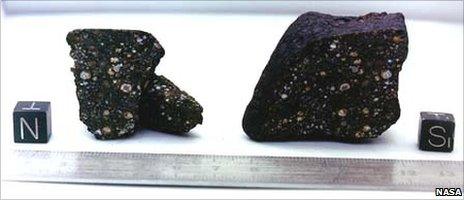Meteorites 'could have carried nitrogen to Earth'
- Published

The research could bolster those who think meteors and comets provided vital ingredients for life on Earth
A meteorite found in Antarctica could lend weight to the argument that life on Earth might have been kick-started from space, scientists are claiming.
Chemical analysis of the meteorite shows it to be rich in the gas ammonia.
It contains the element nitrogen, found in the proteins and DNA that form the basis of life as we know it.
The researchers say meteorites like this could have showered the early Earth, providing the missing ingredients for life.
Details of the study , externalby researchers at Arizona State University and the University of California, Santa Cruz, are published in the journal Proceedings of the National Academy of Sciences.
Life story
The new study is based on analysis of just under 4g of powder extracted from a meteorite called Grave Nunataks 95229, external (named after its place of discovery in Antarctica), discovered in 1995.
On treatment, the powder sample was shown to contain abundant amounts of ammonia as well as hydrocarbons.
Professor Sandra Pizzarello, who led the research, says the study "shows that there are asteroids out there that when fragmented and become meteorites, could have showered the Earth with an attractive mix of components, including a large amount of ammonia".
Meteorites like this could have supplied the early Earth with enough nitrogen in the right form for primitive life forms to emerge, she says.
Previous studies have focused on the "Murchison" meteorite, which hit Australia in 1969, which was found to be rich in organic compounds.
The professor says Murchison is "too much of a good thing" and contains hydrocarbon molecules which you would expect to find at the end rather than the start of the life story.

The meteorite GRA95229 from which a sample was taken and analysed for this latest study
She believes the composition of these compounds are too complex and too random in their molecular shape to have played a role in life on Earth.
Asteroid belt
The theory that our planet may have been seeded by a comet or asteroid arises partly from the belief the formative Earth might not have been able to provide the full inventory of simple molecules needed for the processes which led to primitive life.
The suggestions is that the Asteroid Belt, between Mars and Jupiter, away from the heat and pressure of the forming planets, could have been a better place for such processes.
Collisions between asteroids within the belt produce meteoroids which shoot off around the Solar System and which can carry materials to the Earth.
Dr Caroline Smith, a meteorite expert at London's Natural History Museum agrees the important element in the new study is the nitrogen, even though she would like to see similar results repeated in other meteorites.
"One of the problems with early biology on the early Earth is you need abundant nitrogen for all these prebiological processes to happen - and of course nitrogen is in ammonia.
"A lot of the evidence shows that ammonia was not present in much abundance in the early Earth, so where did it come from?"
What specifically caused life to begin on Earth remains a mystery. Professor Pizzarello hypothesises material from a meteorite may have interacted with environments on Earth such as volcanoes or tidal pools, but says all remains a matter of guess work.
"You find these extraterrestrial materials (in meteorites) which have what you need," she says, "but on the how and when, in which environments and by what means - really, we don't know."
"You can only say that yes, it seems that the extraterrestrial environments could have had the good stuff."
- Published26 January 2011